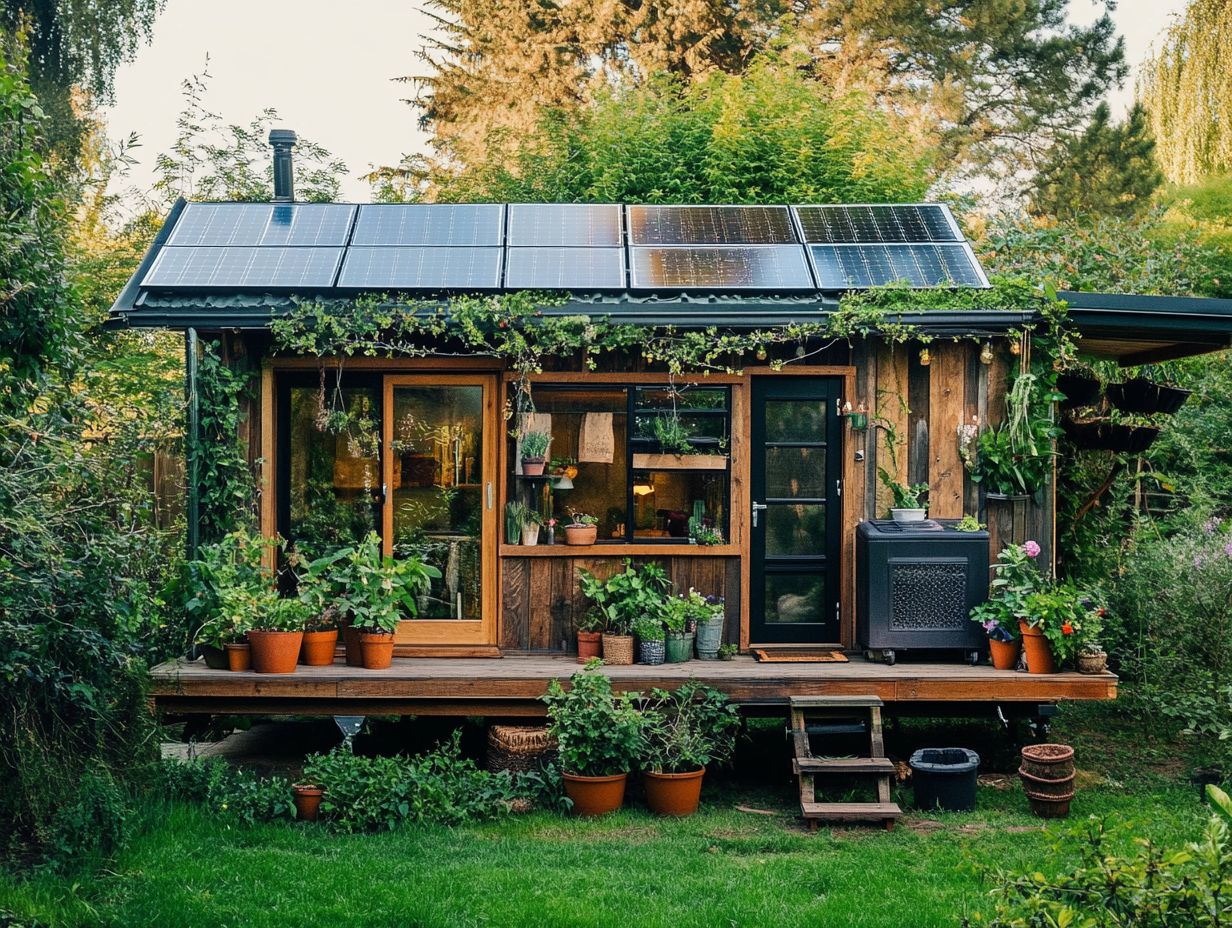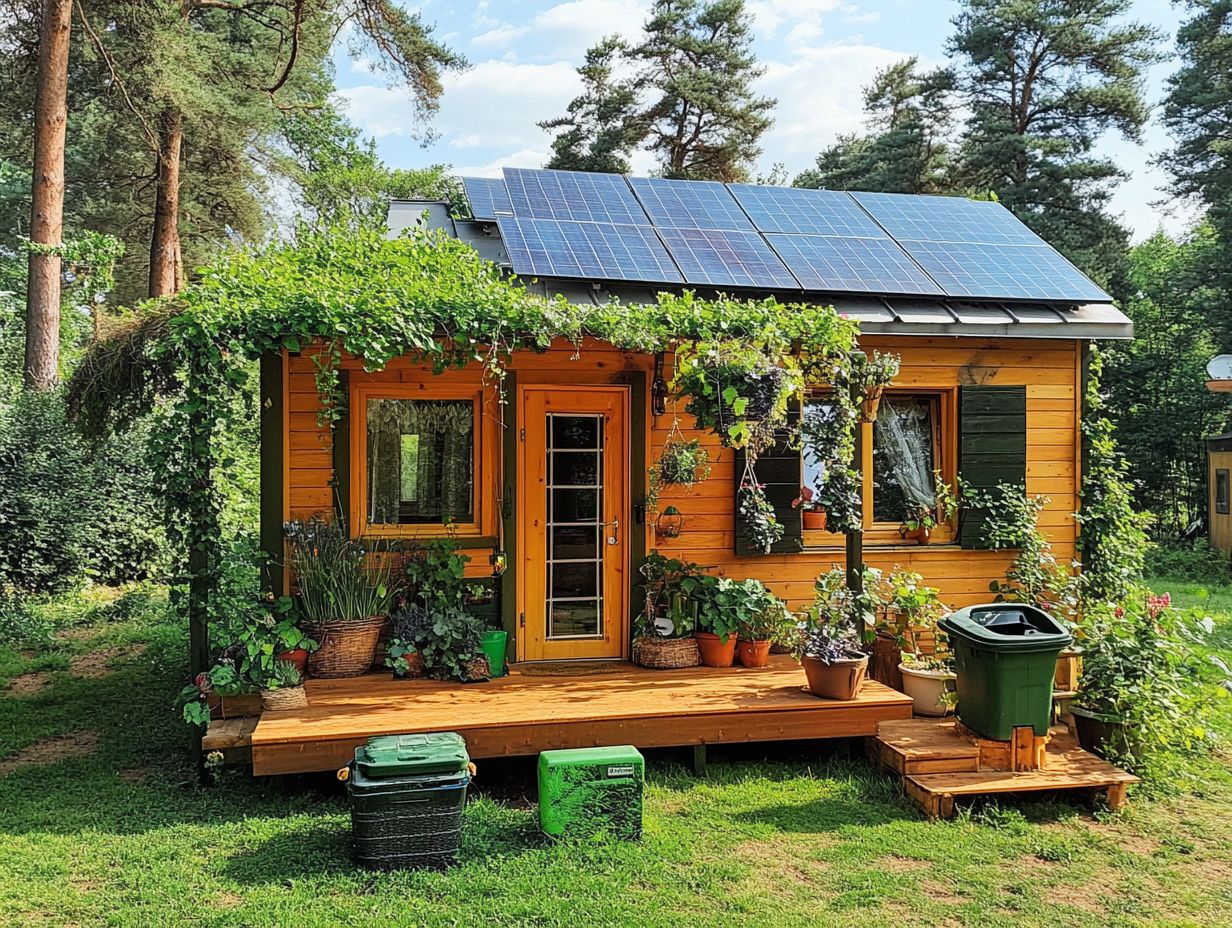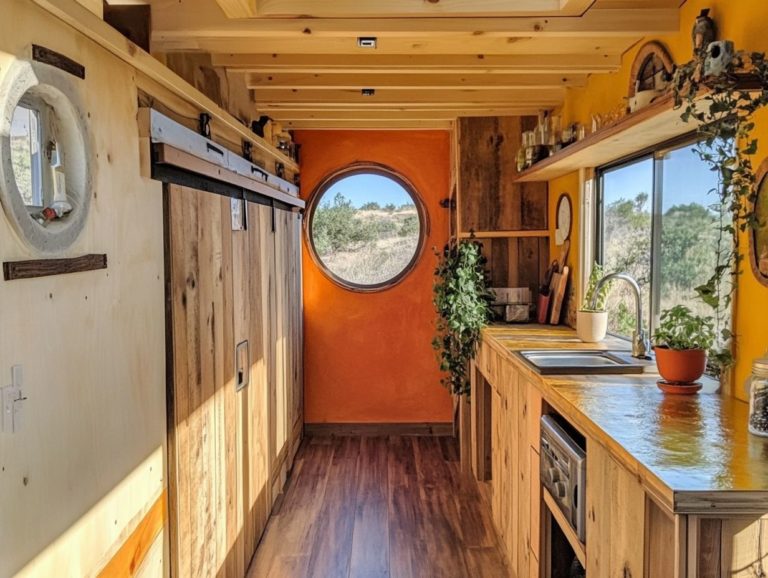How to Incorporate Sustainability into Tiny House Plans
Tiny houses represent more than a mere trend; they embody a lifestyle choice rooted in sustainability and minimalism.
This article delves into how you can instantly transform your space into a vibrant eco-friendly haven! From choosing sustainable materials to maximizing energy efficiency with solar panels, every detail truly matters.
You ll explore innovative water conservation methods, vertical gardening for local food production, and the latest green technologies that can elevate your living space.
Discover how to craft a tiny home that minimizes your environmental impact while celebrating the elegance of sustainable living.
Contents [hide]
- Key Takeaways:
- Understanding Sustainability in Tiny House Plans
- Designing with Sustainable Materials
- Maximizing Energy Efficiency
- Water Conservation in Tiny House Plans
- Utilizing Vertical Space for Gardening
- Incorporating Green Technology
- Frequently Asked Questions
- What is sustainability and why is it important when designing tiny house plans?
- What are some key features to consider when incorporating sustainability into tiny house plans?
- How can I ensure my tiny house is energy efficient?
- What are some sustainable materials that can be used in tiny house construction, reflecting smart design principles?
- How can I incorporate water conservation into my tiny house plans?
- What challenges should I consider when adding sustainability to my tiny house plans?
Key Takeaways:

- Sustainability is key in tiny house plans as it promotes environmentally-friendly living.
- Incorporating sustainable materials and techniques in tiny house design can reduce carbon footprint and promote eco-friendly living.
- Maximizing energy efficiency through solar panels and smart home features can significantly lower energy costs for tiny homeowners.
Understanding Sustainability in Tiny House Plans
Understanding sustainability in tiny house plans is essential for anyone eager to minimize their environmental impact while embracing the perks of a minimalist lifestyle.
By integrating sustainable living practices, you can transform your space into an eco-friendly haven that not only mirrors your personal values but also makes a positive contribution to mitigating climate change.
The Tiny House Movement promotes the idea of compact living as a pathway to greater energy efficiency and reduced material consumption, giving you the power to lead a more intentional and less wasteful life.
Defining Sustainability and its Importance
Defining sustainability requires you to grasp the delicate balance between ecological health and human needs. The significance of this concept lies in nurturing eco-friendly practices that minimize your carbon footprint and tackle urgent challenges like climate change.
These compact dwellings serve as prime examples of how embracing a simpler lifestyle can yield substantial environmental benefits. By reducing energy consumption and emphasizing renewable resources, tiny homes present a tangible solution to the pressing issues we face today.
The movement towards smaller living spaces invites you to rethink how resources are allocated and encourages waste reduction, thereby raising your ecological awareness.
This shift not only helps lower greenhouse gas emissions but also promotes a lifestyle that honors natural habitats, ultimately paving the way for a more sustainable future for everyone.
Designing with Sustainable Materials
Designing with sustainable materials is crucial for crafting eco-friendly tiny homes that not only minimize environmental impact but also elevate aesthetic appeal and functionality.
By utilizing recycled materials and reclaimed wood, you not only reduce waste but also champion a circular economy, staying true to the principles of sustainable living.
Thoughtful design choices, such as incorporating multi-functional furniture and maximizing natural light, can significantly enhance the eco-friendliness of your tiny house plans.
Eco-Friendly Building Materials and Techniques
Eco-friendly building materials and techniques are leading the way in sustainable design for tiny homes, placing a strong emphasis on using reclaimed wood and recycled materials to minimize waste.
By adopting these methods, you contribute to a more sustainable living environment while enjoying unique aesthetic and functional advantages.
Incorporating bamboo as a primary building material is a smart choice, as its rapid growth and renewability make it ideal for environmentally conscious living spaces. Techniques like straw bale construction not only offer superior insulation but also make use of agricultural by-products, effectively turning waste into valuable resources.
Adding solar panels and rainwater harvesting systems further elevates the sustainability of your compact residence, ensuring lower energy consumption and efficient resource management. By choosing these materials and methods, you can significantly reduce your carbon footprint while creating a home that embodies a harmonious relationship with nature.
Start your journey towards a sustainable tiny home today!
Maximizing Energy Efficiency

Maximizing energy efficiency in tiny homes is essential for achieving sustainable living. This allows you to reduce energy consumption and lower utility costs.
By using energy-efficient designs and adding renewable energy solutions like rooftop solar panels and passive solar techniques, you can significantly decrease your carbon footprint.
Integrating smart appliances and high-efficiency fixtures creates a harmonious blend of comfort and sustainability. Tiny homes become the perfect choice for those who are eco-conscious and committed to a greener lifestyle.
Incorporating Solar Panels and Other Energy-Saving Features
Adding solar panels and other energy-saving features is essential for maximizing energy efficiency in your tiny home. This helps you harness renewable energy for your daily needs.
These solutions reduce your dependence on non-renewable resources and contribute to a more sustainable living environment.
By using advanced insulation materials, energy-efficient appliances, and smart home technologies, you can further optimize your energy consumption. For instance, solar panels provide clean energy while lowering your utility costs and offering energy independence.
Tiny home designs now focus on these features, allowing you to enjoy a lower carbon footprint and enhanced comfort. The use of energy-efficient lighting and water-saving fixtures complements the eco-friendly ethos of tiny living, fostering an environment where sustainability aligns seamlessly with modern conveniences. Incorporating sustainable design practices for tiny houses can further enhance this commitment.
Water Conservation in Tiny House Plans
You can make a big difference by conserving water in tiny house plans. This significantly enhances sustainability and minimizes your household’s ecological footprint.
By using systems like rainwater harvesting and greywater recycling, you can maximize your available resources.
Adopt eco-friendly practices like composting toilets to save water. These strategies help you save water and build a responsible relationship with the environment.
Rainwater Harvesting and Greywater Systems
Rainwater harvesting and greywater systems present innovative solutions to enhance water conservation in your tiny home. They enable the efficient reuse of precious resources.
These eco-friendly practices lessen your dependency on municipal water sources and give you control over your water usage.
By capturing rainwater from your roof and directing it into storage tanks, you can create a reliable supply of water for uses that don’t require drinking water, like irrigation and toilet flushing.
On the flip side, greywater recycling allows you to reuse water from sinks and showers. By treating it, you can use it for similar applications. Both systems come with significant advantages, including lower utility bills and a reduced environmental footprint.
As you consider installation, evaluate local regulations, system design, and maintenance requirements. Implement these water-saving solutions now to protect our planet!
Utilizing Vertical Space for Gardening
Utilizing vertical space for gardening is a brilliant strategy that elevates sustainable food sourcing in tiny homes. This enables you to cultivate your own food even in limited areas.
By embracing vertical gardening techniques, you can transform your living space and contribute to community gardens, all while promoting eco-friendly practices. This approach allows you to grow fresh produce while strengthening community connections and fostering self-sufficiency.
Creating a Sustainable Food Source

Creating a sustainable food source through vertical gardening and community gardens is a powerful strategy for enhancing food security in tiny homes. These practices yield fresh produce and bring variety to your surroundings.
By maximizing limited space, vertical gardening techniques empower you to grow a variety of herbs and vegetables in a compact manner perfect for those with restricted outdoor areas. Utilizing trellises, wall planters, and stacked containers can transform otherwise underutilized spaces into vibrant green oases.
Engaging in local community gardens builds social connections, as you and your neighbors come together to grow healthy foods while sharing knowledge and resources. These collaborative efforts improve local ecosystems, attracting beneficial insects and enhancing soil health. They also contribute to a more resilient food system overall.
Incorporating Green Technology
Incorporating green technology into tiny homes is essential for crafting sustainable living spaces that emphasize energy efficiency and saving resources. By integrating smart home features like energy monitoring systems and intelligent appliances you can optimize your energy consumption, reduce waste, and elevate overall functionality.
Embracing eco-friendly practices and technological advancements allows you, as a tiny house dweller, to enhance your quality of life while significantly reducing your environmental footprint.
Smart Home Features and Energy Monitoring Systems
Smart home features and energy monitoring systems are essential for enhancing the sustainability of tiny homes. They provide you with real-time insights into your energy consumption, empowering you to adopt eco-friendly practices that optimize resource use and minimize waste.
For instance, consider smart thermostats. They allow you to control the temperature with precision, ensuring you use minimal energy while staying comfortable. Energy monitoring systems track appliances. This helps you identify energy-hungry devices and adjust your usage accordingly.
Integrating solar panel systems with smart chargers allows you to harness renewable energy efficiently and store any excess power for later use.
And let s not forget automated lighting systems, which can be programmed to switch off when rooms are unoccupied, adding yet another layer of efficiency to your home. Don’t wait! Upgrade to smart home features today to start saving energy.
Frequently Asked Questions
What is sustainability and why is it important when designing tiny house plans?
Sustainability refers to the use of resources in a way that meets the needs of the present without compromising the ability of future generations to meet their own needs. Incorporating sustainability into tiny house plans is important because it promotes responsible and efficient use of resources, reduces environmental impact, and creates a more self-sufficient living space.
What are some key features to consider when incorporating sustainability into tiny house plans?

Some key features to consider are energy efficiency, use of sustainable materials, water conservation, and the overall design and placement of the house on the land. These factors can greatly impact the sustainability and eco-friendliness of a tiny house.
How can I ensure my tiny house is energy efficient?
There are several ways to make a tiny house more energy efficient. This includes incorporating passive solar design, which optimizes your home layout to make the best use of sunlight. Using energy-efficient appliances and lighting, along with proper insulation, will also help reduce heating and cooling needs.
What are some sustainable materials that can be used in tiny house construction, reflecting smart design principles?
Some sustainable materials to consider are reclaimed or recycled materials, such as salvaged wood or metal, as well as materials with a low carbon footprint, such as bamboo or straw bales. It is also important to choose materials that are durable and non-toxic.
How can I incorporate water conservation into my tiny house plans?
Installing low-flow fixtures, like faucets and toilets, can significantly cut water usage in a tiny house.
Using rainwater harvesting systems can help you collect and reuse rainwater. Greywater recycling systems allow you to recycle water from sinks and showers.
What challenges should I consider when adding sustainability to my tiny house plans?
Finding suitable sustainable materials can be tricky. Balancing initial costs with long-term savings is also essential.
Be aware that some areas have zoning restrictions or building codes that might limit your sustainable design options.






